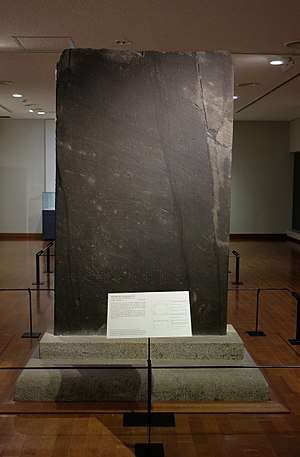Cheonsang Yeolchabunyajido
Cheonsang Yeolcha Bunyajido (Korean: 천상열차분야지도; Hanja: 天象列次分野之圖; Korean pronunciation: [t͡ɕʰʌnsɐŋ jʌɭt͡ɕʰɐ puȵɐd͡ʑido]) is a fourteenth-century Korean star map, copies of which were spread nationwide in the Joseon Dynasty. The name is sometimes translated as "chart of the constellations and the regions they govern."

.png)
| Cheonsang Yeolchabunyajido | |
| Hangul | 천상열차분야지도 |
|---|---|
| Hanja | 天象列次分野之圖 |
| Revised Romanization | Cheonsang Yeolcha Bunyajido |
| McCune–Reischauer | Ch'ŏnsang Yŏlch'a Punyajido |
King Taejo ordered royal astronomers to carve the constellations on a flat black stone in December 1395. The stone is about 122.5 cm in width, 211 cm in height, and 12 cm in depth. The engraved stone shows the 1,467 stars visible from Korea,[1] 264 constellations and their names, the ecliptic and equatorial lines, and 365 scales around. It was compiled through a combination of a Goguryeo star map with more recent observations.
The chart shows positions of the heavenly bodies in their natural order and allocated on their respective celestial fields. Its map projection law is found to be the polar equatorial and equidistance projection : the linear distance of an object on the map from the center is lineally proportional to the north polar angular distance.
The epoch of the stellar positions is estimated to be near the First Century for the stars with declination less than fifty degrees, and to be near 1395 AD for stars with declination higher than fifty degrees.
This map became standard during the Joseon dynasty, with numerous copies printed and disseminated throughout the kingdom, until it was superseded by Western planispheres in the nineteenth century.
The map is the 228th national treasure of South Korea, and is exhibited at the National Palace Museum in Seoul.[2]
The map is now used as a background image on the reverse of the 2007 issued 10,000 won banknotes and was featured in the opening ceremonies of the 2018 Winter Olympics in PyeongChang.
See also
- Yi Soon-Jee famous Korean astronomer during the Joseon dynasty,
- Chil Jong-San, Korean scholar credited with having calculated the positions of five major planets and solar-lunar eclipses
- Astrology
Notes
References
- Sang-woon, Jeon (1998). A history of science in Korea. Seoul: Jimoondang. ISBN 89-88095-11-1.
- "World Beat: Astronomy in Bloom". Korean astronomy. Archived from the original on May 21, 2006. Retrieved January 1, 2006. Published originally in Mercury Magazine, Vol. 28 No. 3, May/June 1999
- "Newton graphic science magazine". Korean astronomy (in Korean). Archived from the original on September 28, 2007. Retrieved January 1, 2006.
- "History of Korean astronomy". First period. Archived from the original on September 1, 2005. Retrieved January 1, 2006.